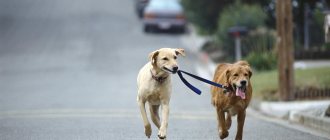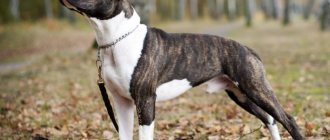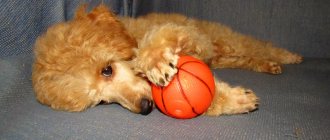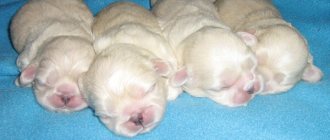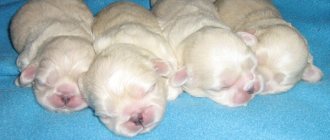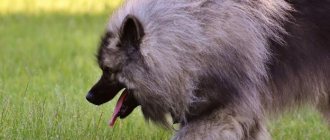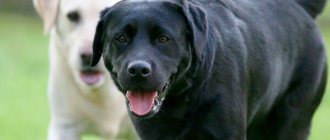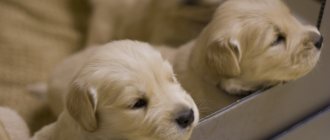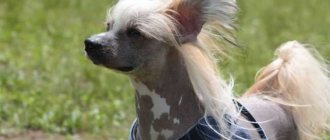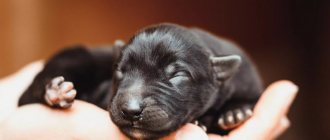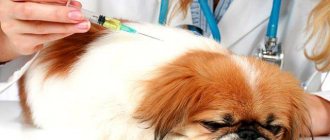One of the most loyal and kind dog breeds is the Labrador Retriever.
Dogs of this breed are distinguished by their intelligence and friendliness.
Thanks to these qualities, they are considered the best guide dogs.
Labrador gets along well with all family members: from children to the elderly.
Like all purebred dogs, Labradors should be purchased from a breeder to ensure the purity of the breed.
Photos of newborn puppies
Newborn Labrador Retriever puppies have ears and eyes initially closed; they are unable to regulate their body temperature on their own, so they must be kept in a warm room (do not keep them near a radiator or fireplace, this can harm them). Usually the mother provides the desired temperature, keeping the puppies warm.
Externally, the puppies already look like adult representatives of the breed, but they are a smaller copy of them, the muzzle is less pointed.
Puppies open their eyes at about 10 days, there may be delays up to 16 days.
At this age, thermoregulation begins to improve.
NOTE!
You should be careful, since it is during this period that the bitch’s hormonal levels change, which is why the puppy may have temporary digestive problems.
The weight of newborn puppies ranges from 400 to 550 g. Height at the withers is from 12 to 15 cm. Usually a bitch gives birth to up to 5-10 puppies.
Breed standard
When buying a dog with a pedigree, you are paying a lot of money and therefore you must know the breed standards, by which you can determine whether the dog is purebred or not. the Labrador Retriever breed standards .
Adult Labrador Retriever on a walk in the spring
You can distinguish a Labrador by its character. The dog is constantly showing friendliness and is on the move. But other breeds may also have such qualities, so you should not rely only on the dog’s character.
The head has a wide skull with almost smooth skin. Brown eyes and small drooping ears are clearly visible on the muzzle. The limbs are strong. They are well developed for high jumping. You can distinguish a real Labrador by its fur. This breed is quite tough and has a waterproof layer.
This is due to the fact that these dogs are natural swimmers. Remember that the Black Labrador Retriever cannot have any other colors on its coat. The same goes for other colors. The only acceptable deviation from color is a white spot on the chest.
By these standards, you can easily distinguish a purebred dog. Any deviations from them are considered abnormal and are recorded when examining the dog. Some standards can even be seen in the photo of a Labrador Retriever .
Many people do not understand the difference between a Labrador and a retriever. These dogs are not much different. These are mainly external differences: color, coat. But if you choose this or that breed, you will not regret your choice.
Development by day in the first month
Every day after the puppy is born, there is an increase in weight. In the first month, approximately 100-150 g per day.
From days 1 to 14, newborn puppies can only crawl and suckle at their mother's breast, gradually their sense of smell develops, and they independently try to find their mother.
It is necessary to closely monitor the puppies' temperature and avoid hypothermia when the body temperature drops to 34 degrees Celsius. If the puppies have a low temperature, they should be warmed up immediately on your chest. This method is the most effective and correct.
From 15 to 30 days, puppies open their eyes, a noticeable reaction to light, sounds, and nearby movement. At this time, animals begin to go to the toilet on their own and their teeth are cut. Dogs are becoming more and more active, starting to crawl and even run.
From days 21 to 30, the puppy begins to recognize the people around him. During this period, you need to especially carefully protect the puppy’s safety: it is forbidden to make loud noises, as this can negatively affect the pet’s condition. During this period, small Labradors learn the behavioral patterns of dogs.
Groundbait is introduced, which can cause small Labradors to experience diarrhea; this is a normal phenomenon, as they find it difficult to tolerate changes in diet. This should not be a cause for concern as long as the color and smell of the discharge does not change.
IMPORTANT!
If there are changes in the smell and color of the discharge, treatment must be started immediately. For this purpose, special medications are suitable to help normalize the functioning of the gastrointestinal tract.
Growth from 1 to 12 months
The first year of a Labrador’s life deserves special attention:
| Age | Weight | Height | Description |
| 1 month | 3.4-4.8 kg | 23-32.5 | A wet and cold nose, an elastic belly, a uniform coat color, a tail similar to that of an otter. The one-month-old puppy is playful and active. |
| 2 months | 7-8 kg | 30-32.5 | At this age, the baby feels comfortable away from his mother and other puppies. Baby teeth begin to develop. |
| 3 months | 12-14 kg | 39.5-42 | It grows actively and becomes restless. From the moment of birth, growth triples. |
| 4 months | 17-19 kg | 44-46 | An awkward body, the so-called teenage period. Teeth begin to cut. The differences between females and males are visible. |
| 5 months | 21-22 kg | 48-51 | The paws lengthen, the puppy becomes stronger. Teeth change. In male dogs, the testicles droop. |
| 6 months | 24-26 kg | 50-55 | The puppy must know all commands and obey easily. Getting used to using the toilet outside the home. |
| 7 months | 26-28 kg | 52-56 | Puberty is reached. All the teeth have already changed. |
| 8 months | 28-30 kg | 54-57 | Bitches are ready for heat and can begin to mark their territory. |
| 9 months | 30-32 kg | 54-58 | The last stage of growing up occurs. The weight reaches its typical level (for females 27 kg, for males 30 kg). |
| 10 months | 32-34 kg | 54-58 | The puppy looks like an adult, its physique is completely formed. |
| 11 months | 34-36 kg | 54-60 | The dog stops growing. |
| 12 months | 30-38 kg | 54-61 | Puppies finally take on the appearance of adult dogs. Powerful and strong paws, short tail, thickened at the base. |
The growth of Labrador puppies depends on genetics, but full maturity is achieved at the age of 12 months.
Basic care rules
When caring for a Labrador puppy, you must follow several rules:
- Monitor his body temperature (several degrees above the environment, but not less than 35 degrees).
- Monitor the puppy's weight and feeding (every hour and a half, it is best if the mother is constantly with the puppies).
- If you are underweight, you should intervene and start feeding them or check the condition of the gastrointestinal tract and start treatment in a timely manner.
- When teeth begin to erupt, give him the opportunity to chew on something.
- Monitor your puppy's stool (color, smell, consistency).
- Training (starts at 2-3 months).
- Hair care (constant combing, keeping clean).
- Timely vaccination (puppies are not protected from all diseases, so vaccination is one of the most important stages; this should be done at the age of 16 weeks).
Why does my puppy urinate frequently?
Newborn Labrador puppies cannot defecate on their own, so their mother licks them to stimulate the discharge.
This reflex can remain with the puppy even as he begins to mature. This is due to the fact that he does not yet have full control of his bladder.
This should go away over time, but if the owners notice unusual behavior in the puppy, this may indicate a disorder. Mostly, frequent urination can be a result of fear or stress.
The only thing that can be done in such a situation, when the puppy urinates frequently, is to contact a veterinarian, who will identify the cause of the behavior and prescribe medications, or send the pet to a canine psychologist.
Character traits
If you describe the Labrador’s character in two words, it would be like this: a peace-loving intellectual. Indeed, this description contains the main character traits of this breed. In addition, they are very cheerful, cheerful, always ready to play and very trusting, even naive.
About the game! Labradors love to run, jump, and swim. By the way, Labrador is the only dog breed in the world that has webbed feet, which allows them to swim well. If a dog finds a puddle on its way, it will not pass by, but will definitely splash in it. Don't even try to scold your pet for turning over a bowl of water.
Labrador puppies need training from the first months of life, since in their simplicity they can be stolen by anyone who lured them into play.
They lack the makings of a leader, which proves their “cooperation” with cop dogs. Labradors are smart and have excellent reactions.
The spontaneity and good nature of these dogs can charm even those who do not love dogs.
How to toilet train?
to toilet train your puppy as soon as he begins to move around and defecate on his own. Training takes place in 2 stages: home and street. First you need to teach your dog to relieve himself on a diaper or oilcloth.
CAREFULLY!
It is dangerous for an unvaccinated dog to walk outside the home, as the risk of disease increases significantly.
At first, you need to carefully monitor your pet’s behavior. Typically, bowel movement occurs immediately after sleep or immediately after feeding. As soon as the puppy begins to walk restlessly and sniff, the owners should help him do his business in the right place. This should be a signal of readiness.
Under no circumstances should you scream or hit your pet for urinating in the wrong place. The puppy is still small and just learning, and shouting and violence can harm him both physically and psychologically. The owner should be a protector and friend, not a tyrant.
You should definitely praise your pet for doing things where necessary and even reward him with a treat.
Don’t be surprised if the puppy manages to leave a puddle overnight. He simply does not know how to endure; this skill will appear only with age.
The second stage is not much different from the first. All the same machinations must be carried out on the street. There is no need to be shy about praising your dog and showing sincere joy when it successfully goes to the toilet; this will only be beneficial.
When walking a dog (for the purpose of toilet training on the street), you need to try to protect it from distractions: people, cars, other animals.
Nutrition in the first 3 months
The difficulty in keeping these pets in the first months lies not only in toilet training, but also in proper feeding. The digestive system of this breed is very delicate and reacts sharply to changes in diet. Therefore, this issue must be approached with all seriousness.
For the first month, the puppy feeds on mother's milk, but if there is a deficiency of calories and nutrients in it, the puppy may lose weight. In this case, you need to help him with additional nutrition.
At the age of up to 3 months, you need to pay special attention to the frequency and timing of feeding small puppies. The interval between meals is at least 1.5 hours, duration – no more than 20 minutes. You should not force feed the animal, but you should not allow it to be distracted while eating. If feeding turns into play and pampering, you need to stop it immediately.
NOTE!
You should always make sure there is water in your dog's bowl. It should always be clean and fresh, and the pet should have unlimited access to it. If you refuse to drink or feed, you should immediately consult a doctor. This may indicate serious illness.
It is best to start feeding with liquid cereals, since the pet is not able to chew food fully (teeth simply have not developed). Gradually, you can get used to dry food, which will be soaked in kefir or yogurt before feeding. To help the growing body cope with food, it is recommended to give your puppy prebiotics. This should also be done if you have loose stools.
Training
The white Labrador is very intelligent and therefore easy to train. It is very important for the owner to take a leadership position. To do this, teach your Labrador to share food with you. During training, be patient; Labradors take a long time to learn commands, but remember them for life.
Conduct training daily, give tasks in a calm, commanding tone. You cannot beat, humiliate, or shout at dogs. With proper upbringing, you will not only have a beloved pet, but also a faithful companion.
How to feed a grown pet?
With each month, puppies need to reduce the number of feedings per day and increase portions.
First, you need to feed the dog 5-7 times a day and give it 300-350 grams of food per day. That is, about 50 grams per meal. At 3 months, the portion increases to 400-450 grams per day, and the number of feedings decreases to 4-5 times a day.
Sample menu for the week:
- Liquid oatmeal – 2 times a day. One boiled egg. Kefir.
- Liquid buckwheat with finely chopped boiled meat, yogurt, grated cabbage.
- Rice porridge in water, with the addition of a few drops of vegetable oil, fish, grated pumpkin.
- Buckwheat (can be made thicker), medium-chopped meat, grated potatoes (raw).
- Cottage cheese, oatmeal, pumpkin (grated), fish.
- Coarsely chopped meat, carrots (grated), raw yolk, rice porridge.
- Fresh herbs (added to the porridge), porridge at your discretion, meat, grated zucchini.
If necessary, you can include vitamins prescribed by a veterinarian and various nutritional supplements in the menu. You can also use homemade supplements.
Which dry food to choose?
Several criteria for choosing the right dry food:
- the most important thing is that the puppy must like it;
- the pet should not be allergic to it or intolerant to the products present in the composition;
- availability;
- the price must be acceptable to the owner;
- quality.
It is best to avoid buying the cheapest food, as it may be of poor quality. For puppies, it is better to choose special food designed for early feeding. Royal Canin and NaturVet are considered popular dry foods.
Introducing complementary foods
The first complementary foods are given to puppies after teething. This is a soaked specialized dry food or homemade diet.
Both of these options have their pros and cons, and professional breeders differ in their preferences. Expert opinion
Tolkachev Andrey Mikhailovich
veterinarian
I do not consider ready-made balanced foods, because I believe that any artificial mixture differs from “live” natural products. And the point here is not in the composition or selection of certain ingredients. Ultimately, you can choose any composition of proteins, fats and carbohydrates with vitamins and microelements, but it is impossible to guarantee the biological activity of the components of a freeze-dried (canned) product and their corresponding effective absorption, digestibility and utilization.
The puppy should be active and cheerful, with a good appetite and regular bowel movements. Any changes in the animal’s well-being and behavior - lethargy, refusal to eat, nausea, vomiting, diarrhea - require consultation with a veterinarian!
Vaccination schedule and which ones should be done?
The table below shows which vaccinations are required for a Labrador by age:
| Name of the disease | Primary vaccination | Revaccination | Subsequent vaccinations | |
| First vaccination | Second vaccination | |||
| Rabies | 4 months | – | 12 months | Every year |
| Plague | 2-2.5 months | In 3-4 weeks | 12 months | Every year |
| Infectious hepatitis | 2-2.5 months | In 3-4 weeks | 12 months | Every year |
| Parvovirus enteritis | 2-2.5 months | In 3-4 weeks | 12 months | Every year |
| Canine parainfluenza | 2-2.5 months | In 3-4 weeks | 12 months | Every year |
| Leptospirosis | 2-2.5 months | In 3-4 weeks | 12 months | Every year |
| Trichophytosis | 1 month – six months | In 1.5-2 weeks | 12 months | Every year |
| Microsporia | 1 month – six months | In 1.5-2 weeks | 12 months | Every year |
How to bathe properly?
The next aspect, which is no less important when caring for a Labrador, is bathing. You should not bathe your pet often; do it only when absolutely necessary. Since the Labrador's coat repels water, it will be quite difficult to get your dog wet. You can bathe with or without shampoo.
Do not allow water or shampoo to get into your ears, eyes or mouth.
This breed loves to splash in the water, but they are not always able to endure the washing procedure.
Cleaning teeth, ears and trimming nails
First, you need to carefully examine your ears and teeth for inflammation or infections.
To clean your ears, you can use cotton wool, gauze, cotton pads, cotton swabs or special wipes.
You can brush your teeth yourself by wrapping your finger in gauze or a bandage, or with a special brush. You can also use teeth cleaning products purchased at a pet store.
As for trimming claws, if the owner does not have sufficient experience, it is better to contact a specialist. In any case, you need to buy special tweezers for cutting.
How to care for wool?
The coat of Labrador puppies is smooth and short, so it is not very difficult to maintain. It only needs to be combed 2-3 times a week with a special brush.
If your puppy has dandruff, you should contact your veterinarian. Many people advise increasing the humidity in the house or moisturizing the pet’s skin directly with special lotions. You can also try changing the food.
Frequent bathing can also lead to dandruff, however, washing with a special shampoo will not hurt.
Labrador Retriever
- home
- Articles
- Encyclopedia of Animal Species
- Dogs
- Labrador Retriever
- Content
- About the breed
- Breed characteristics
- Keeping and caring for a Labrador Retriever
- Story
- Commentary on the standard
- Standard
- Information sources
Introduced from Newfoundland at the beginning of the 19th century to England. Appeared in Russia at the end of the twentieth century. Height at the withers is 54-62 cm with a weight of up to 35 kg. The coat is short, thick, without fringes; color is solid black, brown or hard fawn to red fox. Ears are drooping. The tail is a distinctive feature of the breed: thick at the base, tapering towards the end, evenly covered with hair (otter). Used as a field hunting dog.
About the breed Labrador Retriever or simply Labrador is one of the most popular breeds in the world, the dog of kings and presidents, stars and ordinary employees, the blind and disabled, police officers and rescuers. The list of celebrities who own Labradors is very long: the Queen of England and the American President, the French President, Prince Charles, the royal family of Monaco, the Rothschild family, Charles Aznavour, Nikolai Karachentsev, Joe Dassin... However, this breed was originally bred as a working dog, so many Labradors are still used as gun dogs, guide dogs, and rescue dogs. The breed originates on about. Newfoundland on the east coast of Canada. Research results show that there are three versions about the origin of the name “Labrador” for the breed. The first Labradors were exclusively black, resembling the labradorite stone in color. Perhaps Labradors got their name in honor of this stone. The second version says that the ancestors of Labradors were bred on the Labrador Peninsula. And the third is that Labradors were so nicknamed by the Portuguese for their amazing performance, calling them labradors, which translated from Portuguese means “hard worker.” Retrieving for a Labrador is an innate skill and true passion. The Labrador was bred for a specific role in the hunt: it remains motionless and silent and watches, never taking its eyes off the hunter. His role begins only after the shot. On command, he rushes to where the game fell. No one can notice and remember where the game fell better than him; he has an exceptional memory. Some dogs are able to retrieve game in the order in which it was shot. Having grabbed the game very softly, he runs back, joyfully wagging his tail, to give the prey into the hands of the owner. Great job! If the game is only wounded - and a wounded bird that is trying to fly away is difficult to find - the Labrador has no equal in perseverance and subtlety of instinct. He can work together with the cops or, according to the old tradition, participate in a round-up hunt, but we are forced to admit that such a large classic hunt is accessible to a very narrow circle, and in the modern world, although this upsets adherents of traditions, the Labrador is increasingly the happiness of those who hunts with only one dog. Of course, the Labrador does not stand, but looks for game in the bush and picks it up. The most important thing is to teach him to stay nearby, 20-30 meters away. This is not difficult, as the Labrador is manageable and adaptable. The Labrador feels great on solid ground, it can hunt pheasant, hare, etc., but it has its own preferences... Duck hunting in marshy areas is its true calling. At any water temperature, he rushes into it for game; he is able to get game from a depth of 2-3 meters. Speaking about the fact that the Labrador has a golden character, it should be added that his health is ironclad. He is an exceptionally tough dog with very little to bother him, perhaps only extreme heat. Neither snow nor freezing rain bothers him. You don't need to make any special efforts to make him look good - just run a brush through his fur once a day. From all points of view, the Labrador is a dog close to nature. Of course, you don’t have to take your Labrador to the pond every Sunday to chase the ducks to keep him happy. He is perfectly suited to being a companion dog in the city, but he may have other wants and needs than lying on the couch. He has to do something - even if it’s just to bring slippers! Any activity will be very useful for the mind and body of a Labrador - unfortunately, we don’t have that much choice, but in France Labradors are engaged in towing a skier, searching for truffle mushrooms (several Labradors reached the finals at the French Championship in this discipline), mastering the hard work of rescue dogs or learning to search for people on the water, under water, in the mountains, and, of course, Labradors engage in agility with great pleasure. This breed has retained excellent qualities for family life and work thanks to cultivated hereditary traits.
Breed Characteristics The Labrador is called the king of retrievers. He reacts quickly to everything, is confident in his abilities and persistent in achieving his goals. Very instinctive, and also an excellent swimmer. Finds and retrieves dead game both on land and in water. He has a remarkable visual memory and can remember the places where several birds fell at once. Balanced, never shows aggression, considered one of the most loyal dogs. Needs skillful guidance and gentle training. The intelligence of Labradors is not inferior to their nobility and devotion. It seems that they are born into the world to enjoy life and love it. And the Labrador is ready to generously share this love with everyone! When raising a Labrador Retriever, there is no need to constantly prove “who’s boss”; they never claim leadership. Labrador is very sensitive to punishment and a strict intonation is quite enough. He is extremely inquisitive, energetic, and with the help of play and encouragement you can simply create “training miracles.” Obedience, ease of training and excellent character have made Labrador Retrievers a universal breed. At first they were fearless sailors, then tireless hunters, and have long been happy to cope with the role of a companion dog. And in recent decades, thanks to its intuition, patience, and selfless devotion to people, the Labrador has become an excellent guide for the blind and an assistant for the deaf. An excellent sense of smell combined with an uncontrollable curiosity made Labrador Retrievers one of the best for finding drugs and explosives and an unsurpassed assistant to rescue teams during accidents and natural disasters. And that is not all! Labradors have been used abroad as therapy dogs for many years. They are specially trained to communicate with very sick people, including children. The results of such communication are simply phenomenal. Labradors are therapists who also help epileptics. They anticipate the moment of the onset of a seizure and warn the person to go to a safe place. Their devotion and understanding with their owners is extraordinary. There is another profession for the Labrador Retriever. Police dog. Such a dog must find, capture and detain the criminal. Many may be horrified by such a thought (after all, this is a Labrador!), but you need to understand that the Labrador Retriever treats such work as a game and performs it absolutely without aggression. It is precisely because of the lack of anger and hyperexcitability that in many countries police officers prefer to work with Labradors. Their excellent work is dictated not by bloodthirstiness, but by devotion and the desire to be useful to the owner. And the search and rescue service on the water seems to be specially created for the Labrador - a natural swimmer, capable of working even in icy water! The capabilities and talents, intelligence and amazing spiritual qualities of the Labrador Retriever can hardly be overestimated. Labradors have the only “flaw” – they are too trusting and friendly. And owners of Labrador Retrievers should always remember that not all dogs, and not all people either, have a similar “flaw”.
Maintenance and care of a Labrador Retriever It can live in an apartment provided it goes on long, active walks. It is necessary to brush the coat 2-3 times a week, and comb it out during shedding. The Labrador is a strong one, but an elegant one. From the very beginning, the breed was bred for work and has retained the physical condition necessary for this. The Labrador's anatomy corresponds to its purpose: powerful jaws designed for retrieving game, short dense coat with a thick undercoat that protects from the cold and is almost waterproof - even if the dog gets dirty, after the coat dries, all the dirt “rolls off” from it, webbed feet and an otter tail, facilitating movement in the water. The Labrador has rounded ribs (even as a puppy), but he himself must be compact and, preferably, without excess weight. Often, veterinarians unfamiliar with the specifics of the breed prescribe a light diet where it is absolutely not necessary. However, if a Labrador gets overweight, it is due to an unhealthy lifestyle. For an urban Labrador, the “sofa - sidewalk - sofa” mode is typical, but not useful. And yet, it is better to add a little daily physical activity and continue to give the usual diet: if it is dry food, then a little less - but in no case more than what the manufacturer offers, if it is natural products - then no more than 600 grams of meat, rice and vegetables. And remember - the only drawback of a Labrador is that he loves to eat!
History The Labrador is an extremely popular breed all over the world, ranking high in popularity in the UK, USA and almost all Western European countries. Queen Elizabeth II of Great Britain and Prince Charles, the Queen of Belgium and the Princess of Monaco, Jacques Chirac and Ted Turner, Vanessa Paradise and Arnold Schwarzenegger are just a small list of happy Labrador owners. In our country, this breed is becoming more and more famous and beloved, and this is not surprising - people are gradually realizing that what bites and barks is not always good. Indeed, among large dogs, the Labrador is the best choice for a city dweller: it has a stable psyche and excellent health, it will not be too intrusive in communication, its pleasant and friendly character will appeal to every family member, especially since the dog is quite versatile: it is an excellent gun dog, irreplaceable on any hunt, will gladly find and serve a shot bird not only on land, but also in water, as it has an extraordinary love for swimming and fetching; Labrador is both a family pet, a nanny, and a sports dog - agility with a Labrador is a very spectacular sport. Labrador is a true athlete, he is perky, passionate and hardworking. The Labrador does not require owners to spend long hours on training grounds, because it is a very “intelligent” dog - it understands the owner at a glance and a few lessons are enough for your Labrador to understand what they want from him. A Labrador will be an excellent companion for an elderly person, because this dog does not require high loads and will be happy with short walks in a park or square. When getting a Labrador, you won’t hear empty barking from him, and don’t really count on protecting your property - for years, selection has been carried out only for a friendly disposition, this dog is ready to do anything to please a person. The first mention of Labradorite dates back to 1593. In a report on the voyage of the Marigold to the Cabot Strait area, the crew met “natives with their black dogs, smaller than a greyhound, who followed on their heels.” These dogs were different from the dogs from the mainland that belonged to the local Indians and were invariably called “black” when they were described. This black Newfoundland dog is the main ancestor of modern Labradors, Newfoundlands and several other breeds. Farley Mowat, a Canadian writer and biologist, writes in his book “Tragedies of the Sea” that until the 1950s, dogs with clear signs of the ancestral breed could be found in some distant ports on the coast of Newfoundland, where they were simply called “divers”. However, the exact origin of Labrador is still not fully understood. It is known that the first representatives of this breed came to England from the east coast of Canada - from the island of Newfoundland, and therefore were first called St. John's Newfoundlands. Interesting research on the history of this breed by Dr. Michael Woods, owner and breeder of Labradors from Canada (Waterdog nursery). He refutes the prevailing concept that dogs from Newfoundland, having been taken on fishermen's ships to the English port of Poole, were ennobled by the influx of blood from pointers and black hounds of St. Hubert, which added a subtle scent and hunting dexterity to their unrivaled fetching abilities. He believes that the breed was not only born in Newfoundland, but developed there until the export of these wonderful dogs to England was established. The British only discovered the breed, imported it to England, preserved and refined it. Nevertheless, the type of dog brought from Newfoundland was practically no different from the modern one. Recent excavations by archaeologists in the village of Port aux Choix on the island of Newfoundland have uncovered skeletal remains of dogs dating back to 1937 BC. e. Dr. Woods suggests that Viking dogs, who arrived there in 1000 BC, contributed to the formation of the breed in Newfoundland. e. and the dogs of the Basques, who were on the Labrador Peninsula from 1500 to 1700. The main thing that struck the Europeans who first saw the “Newfoundlands” was their desire to work in water and on land in any weather and love for water. On the Labrador peninsula, two types of dogs were distinguished: “Great Newfoundland” - a dog with long shaggy hair, large, raw build, more often used by local residents to transport firewood to houses. The “Small Newfoundland” was a type of dog that was lighter, with short, hard, non-wetting hair, of medium size, unusually dexterous and active, with excellent scent and adoring water. At the beginning of the 19th century, in the circles of the English aristocracy, long-haired dogs were a symbol of prosperity and a tribute to fashion, thanks to which mainly larger long-haired individuals were exported from the peninsula, which later retained the name “Newfoundland” at the same time, the original dogs of “the correct type, black, active, with wool akin to an otter,” there are fewer and fewer left... Until one day, Colonel Peter Hawker, a sea captain and owner of fishing boats, brings a pair of black dogs from one of his trips to Newfoundland. He was the first to use the name of the breed “Labrador” in his “Instructions for Young Sportsmen and All About Hunting and Hunting Weapons” in 1814, where he describes St. John’s dogs as follows: “...much more suitable for hunting; more often black than other colors, not much larger than a pointer; with a long head, deep chest, strong legs, short smooth hair, the tail does not carry high and is extremely fast in running, swimming and hunting...” English aristocrats begin to buy these dogs, and a lot of effort is put into keeping the breed clean, although some brought in the blood of other retrievers and setters. There is no blood of other breeds in the pedigrees of their Labradors. The Labrador became (and remains to this day) an extremely popular retrieval dog. It becomes good form for the highest aristocracy to keep these dogs (the Queen of England is the owner of one of the famous working kennels). At the same time, the breed cultivates the working qualities necessary for retrievers: endurance, strength, love of water; for softer presentation of game, dogs with partial teeth were preferred. As you know, Labradors come in three colors: black, fawn and chocolate. Initially, only black individuals were recognized. The first two yellow Labrador puppies, for the first time in the history of the breed, were received in a litter from black parents and in the family who had only black ancestors, Major Radcliffe in 1899. The male was named Hyde Ben and became the first yellow Labrador registered in England. This dog became the basis for those nurseries who became interested in this color. The chocolate color appeared in litters from time to time, but became recognized as the standard much later. All modern Labradors came from the nurseries of the English nobility at the beginning of the century. An interesting fact is that when a pair of dogs were imported from Newfoundland in 1933 to renew the blood, their type was practically no different from those bred in England! This once again shows the care with which English nurseries maintained the purity of the population. Since the mid-60s, the breed began to clearly distinguish working (hunting) and show lines, and the difference between them is so significant that sometimes it is even difficult to imagine that they are the same breed. Working lines are never mixed with shows, and their whole life is spent in field trials and championships, and among them there are Field Trail Champions (FTCh.), who should not be confused with show champions. Working dogs, as a rule, have lighter bones, are leaner and lighter. Show Labradors have a completely different appearance - a fairly strong dog, with massive bones and a voluminous chest, a powerful head and a wide, full muzzle. But despite the difference in appearance, only one thing is always required from a Labrador: excellent contact with a person, and this can only be revealed by special examination - be it field tests or an exterior exhibition. In the 70s, Labradors of a slightly different type entered the show ring: more raw and heavier, with wide skulls and heavy, short muzzles. Currently, there is a tendency in the breed towards a type of dog that is strong rather than raw in build, more elegant, with special attention paid to the correct angles of the limbs, easy and efficient movements. Leading breeders are calling for greater emphasis on the working qualities of Labradors, to revive the title of Double Champion (Show and Field Champion) in the breed, which existed in pre-war times. There are also small intrabreed differences between dogs of black and fawn lines. As a rule, black dogs are more elongated than fawn dogs, and with a slightly different head structure. The standard recognizes three colors in the breed: black, fawn and chocolate. In recent years, all over the world there has been a clear trend towards an increase in the number of chocolate dogs, which look very impressive. In Europe, mixing fawn and chocolate lines is avoided, as this leads to “fading” of the chocolate color and the appearance of light eyes and fawn dogs with weakened pigmentation (brown nose). In the USA, such principles are not followed and matings between fawn and chocolate Labradors are very common. The main population of Labradors is concentrated in nurseries in the UK, USA, France, Belgium, Holland and Scandinavian countries. The British, as you know, are considered “trendsetters” - they have the most famous nurseries and the largest population of Labradors, despite the small size of the country. Every more or less serious kennel abroad always tries to keep up in its development and looks only to England and works with the blood of English dogs. Of course, in the future, any kennel produces its own type of dog, and each has its own principles of breeding, pairing and intuition, and the kennel either receives worldwide recognition or gradually fades away. Currently, such English nurseries as Bradking, Blondella, Cambremer, Poolstead, Rocheby, Lejie, Sandylands, Kupros and many others have gained worldwide fame.
Commentary on the standard GENERAL APPEARANCE The Labrador Retriever is a strong, powerful dog with strong bones, which, however, should not look too raw. A Labrador's conditioning should enable him to perform effectively in fetching, jumping over obstacles, swimming against strong currents, and have enough stamina to do this more than once throughout the day. Those who do not take these requirements into account when breeding either get individuals with a poor anatomical structure, too light, not having sufficient strength and energy for the strenuous work of fetching, or extremely heavy and loaded dogs that quickly get tired. We must remember that the Standard assumes that the dog must perform its primary function: fetch, and if we decide to own and breed dogs of this breed, we must consider their potential as working dogs, even if we are sure that our dogs will never participate in field trials. HEAD The skull should be wide, the stop point should be well defined. The cheeks are not loose; too damp cheeks give the dog’s face an expression that is not typical for a Labrador. The muzzle should be of medium length, making it possible to present game. A narrow forceps is not advisable. The nose should be large, with well-developed nostrils, which guarantees the dog an excellent sense of smell. EARS The ears are set fairly far back and should be set low. When the ears are set high, the head loses the typical expression inherent in the breed. Ears of the correct size should be close to the head. EYES The eyes are set quite wide and should not be round or protruding, because Such eyes are too vulnerable in a working dog. We strive to see small, oval-shaped eyes in a Labrador that are not set too deep. Color can range from nutty to dark brown, with a "burnt sugar" color being preferred. In America black eyes are acceptable, but in the UK they are looked down upon. Be that as it may, the most important thing here is the expression of the eyes: they should express good temperament and kindness. A glare is not allowed. JAWS Both the English and American Standards characterize the dentition as a “complete and regular scissor bite,” which means that the upper row of teeth faces the lower row without gap. The teeth are located symmetrically and vertically in the jaw. The number of teeth is not specified. NECK AND FRONT The structure of the neck and forelimbs are important for the dog, because. determine the nature of the movement. NECK We want a Labrador to have a strong neck, without dewlap, with good reach and correct shoulder angle. FORE LIMBS The shoulder blades and shoulder are set obliquely, not short, the angle of articulation is about 90. The correct angle of the shoulder-scapular articulation is necessary so that when bringing game the main weight falls on the shoulder, and not on the neck or jaw. When viewed from the front and side, the forelegs should be straight, short, well muscled and with strong bones. The pasterns are strong, slightly sloping, but not “soft.” CHEST The chest should be so wide that a man's hand can fit between the forelimbs. When viewed from the side, the chest bone is at the level of the dog's elbow. BODY The Labrador Retriever should have well developed, arched ribs. chest. The loin is short, strong, wide. The topline is level. HINDQUARTERS The hindquarters are well muscled, with well-defined angulations and hocks. When viewed from behind, the hock joints are straight and parallel. Cow is a serious drawback. Hindquarters with incorrect angles will give poor propulsion when moving. When moving correctly, it appears as if the hind limbs are pushing off the surface with force. WOOL, TAIL The two most characteristic features for the breed and this is noted in the standard. If the coat is formed correctly, you will see the same characteristic “otter” tail on the Labrador. There should be no dewlap on the tail: the tail is very thick at the base and tapers towards the end. The British, like the American standard, defines the length as “average”. A tail that is too long or short will disrupt the overall balance of the dog. The tail, long to the hock joint, creates a pleasant impression. The tail should be level with the back, but Labradors often carry it higher. This is defined by the Standard as a "gaily carried tail", but the tail should never be carried over the back - this is considered a serious fault. The coat should be short and thick, rather rough to the touch. If you pull apart the guard hair, you should be able to see a thick, soft, waterproof undercoat covering the dog's entire body. It may be a lighter shade than the main hair. Many excellent black dogs have a mouse-colored undercoat. Soft wool is considered a big disadvantage for a Labrador, because... does not repel water. Although the American Standard does not emphasize the importance of the undercoat, American Labradors have very good coat quality and excellent otter tails. COLOR Three colors are allowed: black, fawn and chocolate. Black: A small white patch on the chest is acceptable. Eye color should match the coat: brown or hazel is preferred. Fawn: This term defines a range of colors from red to light cream. We object to darkening on the face of fawn dogs, a type of mask that gives them an atypical expression. A small white patch on the chest is acceptable. The eye color is the same as blacks, with black or dark brown pigmentation around the eyes and lips. The nose may lose pigmentation to pink in winter, but this is not a disadvantage. Chocolate: All shades from light to dark are acceptable. Dark color with dark eyes is preferred. The eye color must match the coat. MOVEMENT Movement is very important for a Labrador - it should be light and free. If the structure is correct, the animal will move correctly. The straightness of the movement means that when moving towards you, you should only see the movement of the front limbs. When moving away from you, only the rear ones. Movements should not be too sweeping or mincing. GROWTH Once again, slight differences between the British and American standards: Americans allow slightly higher growth limits. However, an experienced expert will single out a dog even if it is slightly above the acceptable standard, provided it is harmonious in structure and balanced. As one of the most famous breeders of this breed notes: “A Labrador should only remind you of a Labrador. If he looks like another breed of dog, he is atypical.” TEMPERAMENT There is no breed superior in temperament to the Labrador. The Labrador has a big, noble soul and is always kind to people, especially small children. Good temperament, equanimity and intelligence make this breed one of the most suitable for such services as guide of the blind, police dog and we should be grateful to those who developed this breed before us, and to those who continue to preserve these character traits today. Any dog, no matter how good in appearance it may be, if it shows an unstable temperament in the ring or in the pits, must be immediately disqualified.
Standard GROUP: FCI group 8 - retrievers and spaniels. FCI standard No. 122/29.01.1999 ORIGIN: Great Britain. PUBLICATION DATE OF ORIGINAL VALID STANDARD: 06/24/1987. USE: gun dog. FCI CLASSIFICATION: Group 8: Retrievers, Spaniels, Water Dogs. Section 1: Retrievers. GENERAL IMPRESSION: Strongly built, compact, very active with a voluminous head in the skull, a broad and deep chest and ribs, broad and strong hindquarters and loin. BEHAVIOR AND TEMPERAMENT: good temperament, very agile. Excellent instinct, soft grip when serving game, loves water very much. Easily adaptable, loyal companion. Intelligent, insightful and obedient, with a strong desire to please his master. Good-natured and affectionate, without a hint of aggression or timidity. HEAD: CRANIAL REGION: Skull: wide, clean lines, without fleshy cheeks. Transition from forehead to muzzle: pronounced. FACIAL REGION: Nose: wide, with well-developed nostrils. Muzzle: powerful, not pointed. Jaws/Teeth: Medium sized teeth. Strong jaws with an excellent, even, regular scissor bite, with the upper incisors tightly covering the lower ones and the teeth standing vertically in the jaw. Eyes: Medium size, expressing intelligence and good character, brown or hazel. Ears: Not wide or heavy, hanging, close to the head, set far back. NECK: clean lines, strong, powerful, well set on the shoulders. BODY: Back: Topline is horizontal. Loin: Broad, short and strong. Chest: Good depth and length, with well arched ribs. TAIL: A distinctive feature of the breed, very thick at the base, gradually tapering towards the end, of medium length, without dewlap, but covered with dense, short, coarse hair, giving it the appearance of a round "otter" tail. Can be carried gaily, but should never curl over the back. FOREQUARTERS: The forelegs are straight, with strong bones. Shoulder: long, oblique. HINDQUARTERS: The hindquarters are well developed, the croup is not sloping towards the tail. Knee joints: with good angles. Hocks: Low set. Cow positioning is highly undesirable. FEET: Round, balled, well arched, with well developed pads. MOVEMENT: free, productive. Straight and parallel fore and hind legs. WOOL QUALITY OF WOOL: distinctive feature, short, thick, without waves or fringes, hard and dense to the touch, dense waterproof undercoat. COLOR: solid black, fawn or brown (liver, chocolate). Fawn from light cream to fox red. A small white patch on the chest is acceptable. SIZE: Ideal height at withers: males 56-57 cm; females 54-56 cm. FAULTS: any deviation from the above points should be considered as a fault, the assessment of which should be in exact proportion to the degree of this deviation. NOTE: Males must have two full, normally developed testes, fully descended into the scrotum.
Sources of information https://www.labr.ru/ https://www.labri.ru/ https://www.labrador.ru/ https://www.retriver.net/ https://www.labrador- retriever.ru/ https://king-labrador.narod.ru/ https://ru.wikipedia.org/ https://www.infodog.ru/ https://www.labradorworld.ru/ https:// www.merlinschocolatelabradors.com/ https://commons.wikimedia.org/ https://upload.wikimedia.org/ https://www.dog-obedience-training-review.com/ https://acmepetco.com/ https://www.no-pest.com/ https://www.pedigreedatabase.com/
Health to you and your pets!
© 2022 ZOOVET Team We are always happy to help you! 24-hour consultation: +7 Make an appointment [email protected]
Return to list
How to train and what commands to teach?
Training a puppy involves teaching basic commands:
- place;
- to me;
- ugh;
- sit;
- lie;
- give me your paw;
- voice;
- stand;
- fetch;
- front;
- near.
The dog learns each command only through encouragement; under no circumstances should you use physical force or shout. You should start with a nickname and leash training.
Lifespan
The average life expectancy of Labradors is 10-14 years . Mini Labradors from 8 to 12.
Such a significant difference is explained by the accumulation of genetic abnormalities.
Inbreeding or the presence of the dwarfism gene leads to a decrease in the dog’s body’s resistance to various diseases and rapid aging.
Popular nicknames
The question of what to name a puppy should be taken seriously. The name should be simple and suitable for the pet.
The following nicknames are suitable for male Labrador puppies:
- Tyson;
- Jack;
- Bonya;
- Caesar;
- Rex;
- Hachiko;
- Graph;
- Baby;
- Ricci.
The girl can be called by the following names:
- Jaycee;
- Alma;
- Lucky;
- Bagheera;
- Gerda;
- Jesse;
- Nika;
- Eve.
Price range
There are many sites on the Internet where you can find advertisements for the sale of puppies. The cost depends on the country, the age of the dog, its pedigree, titles, etc.
For example, let's look at the price range for a Labrador puppy in Moscow.
So, a pet-class puppy costs from 25,000 rubles. The cost of a show-class puppy, in turn, is equal to 62,000 rubles. And, as they say, you can buy a puppy for 15,000 rubles.
How to choose your future pet?
Choosing a Labrador puppy depends on personal preference. You can choose between a boy and a girl, color and character. It is necessary to observe the behavior of the puppy and its parents, make sure that the breed is pure and has a passport. You need to make sure that neither of the parents has or is sick with anything, as this could be passed on to the puppy.
IMPORTANT!
The most important thing when choosing a puppy is the realization that you are acquiring a new family member who needs affection and care. You will need to monitor his health, hygiene and mood, as well as educate him. In the future he will become the most devoted friend and protector.
Possible diseases
— Labrador can be at risk of obesity. Other breeds hardly suffer from this. To avoid obesity, you need to feed your dog only according to the established schedule and not indulge in tasty treats between main meals. Often it is caring owners who drive this breed to obesity.
— Hip or elbow dysplasia may also occur. Experts cannot definitively name the causes of this disease. There are suggestions that this is due to the dog’s heredity and his lifestyle.
- Panosteitis. More common in young individuals. Manifests itself in the form of pain in the joints.
— Osteochondrosis. Also common among puppies. As with obesity, the reasons are difficult to name.
- Licking granuloma. These are ulcers on the limbs.
— Progressive retinal atrophy. The disease is common in mature dogs. It cannot be cured, but many dogs feel healthy even with this disease.
- Cataract. An eye disease that occurs rarely.
- Epilepsy. It is rare among Labradors. At the first signs, you need to urgently contact a specialist.
